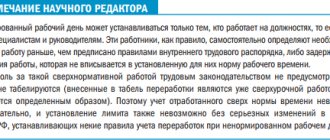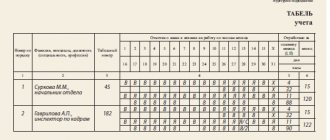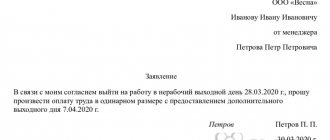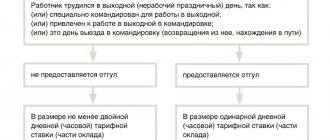Protecting workers' health in hot weather
Rospotrebnadzor published an information message for employers in connection with the abnormal heat. The inspectors reminded that it is impossible to work a full day in conditions of high air temperature; a shortened working day is necessary due to the heat, both in the office and when working outside.
In accordance with the requirements of Article 212 of the Labor Code of the Russian Federation, the employer’s responsibilities include creating normal working conditions for employees, including a comfortable air temperature. If it is not possible to provide work with air conditioning, then you will have to reduce your working hours. The Labor Code of the Russian Federation does not establish rules for working indoors in hot weather: according to the Labor Code, there is only the obligation of the employer to make the place of work comfortable and safe. Details and standard working hours at high temperatures are specified in SanPiN.
IMPORTANT!
Since 01.03.2021, the new SanPiN 1.2.3685-21 “Hygienic standards and requirements for ensuring the safety and (or) harmlessness of environmental factors for humans” has been in force, approved by the Decree of the Chief State Sanitary Doctor of the Russian Federation dated 01.28.2021 No. 2. It contains all important environmental factors affecting human health.
Air temperature standards and permissible working hours
The new SanPiN 1.2.3685-21 establishes acceptable values for microclimate parameters in indoor workplaces. It is obvious that the working conditions of different specialists in the same organization are different:
- someone works in an office;
- someone - in a workshop or warehouse;
- someone is on the street.
Depending on the nature of the activity and the place of work, the requirements for air temperature differ. For example, for office workers in accordance with clause 5.4 of SanPiN 2.2.4.548-96, approved. According to the Decree of the State Committee for Sanitary and Epidemiological Supervision of October 1, 1996 No. 21, normal is considered to be from 23 to 25°C. If the temperature exceeds 28.4°C, it is recommended to set a shorter working day due to the heat. In addition, requirements vary depending on the conditions in which a person works:
- with moderate tension;
- with heavy physical activity.
From SanPiN it follows how much to shorten an 8-hour working day if the temperature in the office has reached 30°C - by 3 hours, the maximum work shift is 5 hours.
In the office
For how long you are allowed to work at high indoor temperatures, see the table:
| T, °C | Working hours in the office |
| 32,5 | 1 |
| 32 | 2 |
| 31,5 | 2,5 |
| 31 | 3 |
| 30,5 | 4 |
| 30 | 5 |
| 29,5 | 5,5 |
| 29 | 6 |
| 28,5 | 7 |
| 28 | 8 |
| 27,5 | No abbreviations |
The temperature conditions in which employees work in the summer are required to be monitored by a labor protection representative or a special commission. If the permissible values are exceeded, a protocol with the measurement results should be drawn up. Based on this protocol, the director of the organization, fulfilling the requirements of SanPin 2.2.4.548-96, will establish a daily routine in the heat and issue an order to shorten the working day. This order must be familiarized to all interested workers: in fact, for them it is downtime at the initiative of the employer. This table shows at what air temperature the working day in offices is shortened: as soon as the thermometer crosses 28.5 degrees, it’s time to shorten the day by 1 hour.
Reduced schedule
Rospotrebnadzor can initiate or recommend adjustments if excessive heat is detected, which is regulated by the Letter dated June 21, 2022. In this case, the workday decreases according to the recorded deviations:
- when the parameters increase to 28.5 - for 1 hour;
- at 29 - 2 hours;
- 30.5 - 4 hours.
At the same time, adjustments to the standard schedule due to the circumstances under consideration will not cause a reduction in wages. This situation refers to downtime, which means payment for unworked time is carried out within the framework of Part 2 of Article 157 of the Labor Code of the Russian Federation.
Outdoor work
Not all work is performed in the office: builders, couriers, gardeners and other employees are forced to spend most of their time outdoors, and the temperature at which they cannot work outside is important to them. Rospotrebnadzor specialists recalled in detail the rules for such work:
- if the air temperature is above 32.5 degrees, work must be stopped;
- reschedule work hours to morning and evening;
- use protective clothing made of thick fabric;
- do not allow those under 25 and over 40 years of age to work in such conditions;
- Have water on hand and drink water often.
The table shows at what temperature you can work outside in the summer when performing different categories of work.
Such indicators are given in SanPiN 1.2.3685-21. Categories I–II are determined based on energy consumption:
- I, a and b are labor functions performed while sitting or with minimal movement;
- II, a and b - performed while walking and moving small loads;
- III, a and b - associated with constant movement and carrying significant weights.
Current punishments
The Code of Administrative Offenses precisely describes at what temperature in a workroom or workshop you cannot work according to the Labor Code, and also determines the types of punishments in case of non-compliance with Sanitary Rules and Regulations. Thus, penalties start from 20,000 rubles, and in some situations the company’s activities are completely limited until a re-inspection is carried out after the inconsistencies are eliminated. In fact, only the Sanitary and Epidemiological Service, which has diagnostic equipment at its disposal, will be able to identify violations of the recommendations of all the authorities mentioned above in the article.
Salary for working hours shortened due to heat
If the working day becomes shorter, then earnings are allowed to be reduced. There are three options:
- Downtime due to the fault of the employer, since he did not provide optimal conditions - in this case, payment is made in the amount of at least two-thirds of the average earnings (this option is applicable if the employee works in a room in which the air conditioner was not installed (repaired) in a timely manner).
- Downtime for reasons beyond the control of the employer and employee - in this case, payment is made in the amount of at least two-thirds of the tariff rate, salary (official salary), calculated in proportion to the downtime time (such payment is possible if the employee works on the street).
- Do not reduce employees’ earnings, maintaining their full wages (as if they worked full time without reduction) - this is relevant when providing breaks during the day, which are included in the employee’s working hours.
Reducing the working day based on the manager’s order is documented as downtime due to the fault of the employer. For such days, regardless of how many hours were actually worked, the following is paid:
- hours worked;
- downtime at a rate of 2/3 of the employee’s average daily earnings based on the norms of Article 157 of the Labor Code of the Russian Federation.
That is, for all the hours that employees were supposed to work, but were unable to due to the heat, the employer is obliged to pay at least 2/3. Thus, such reduced time is not beneficial for employees.
At what temperatures is a shortened working day possible? The answer is!
Greetings, dear friends! I don’t know about you, but here in Novosibirsk it’s a relatively cold period for November. It seems sunny and dry, but due to the humidity and northeast wind it is quite cold. I think that you can try to reduce work at low temperatures. You will learn how to do this from this note.
The main thing here is to understand at what temperatures it becomes possible to shorten the working day. Taking into account the requirements of the Labor Code, hygienic standards contained in sanitary rules and regulations (“R 2.2.2006-05. Guidelines for the hygienic assessment of factors in the working environment and the labor process. Criteria and classification of working conditions” and “SanPiN 2.2.4.548-96 2.2.4. Physical factors of the production environment. Hygienic requirements for the microclimate of production premises. Sanitary rules and regulations”, establishing, among other things, optimal and permissible temperature indicators for workplaces), the head of the company can decide to reduce the working day or stop work at extremely low or high temperatures. But the employees themselves may require this. According to Article 21 of the Labor Code of the Russian Federation, an employee has the right to a workplace that meets state regulatory requirements for labor protection and the conditions stipulated by the collective agreement. According to the law “On the sanitary and epidemiological welfare of the population,” working conditions, the workplace and the labor process should not have a harmful effect on humans. What if not the cold in the workplace can lead to hypothermia and illness? Thus, the employer is obliged to control the microclimate at the enterprise, including the temperature in the workplace. Temperature measurements at workplaces are carried out using a thermometer or psychrometer at least 3 times per working day (shift). After the measurements, it is necessary to draw up a protocol in which to justify and evaluate the measurements taken for compliance with the regulatory requirements of the Sanitary Rules. Only after carrying out all the necessary measurements, the employer can decide to reduce the working day of employees based on the norms of the Sanitary Rules and maintain full wages for the employees, taking into account the fact that the ambient temperature does not correspond to acceptable values. If the work is related to labor activity in the open air, then Article 109 of the Labor Code of the Russian Federation provides for special breaks for heating at low temperatures. These breaks are included in the total working time. And in judicial practice there were precedents when employees defended their right to a warm workplace. In the Determination of the St. Petersburg City Court dated October 25, 2010 No. 14529, the state enterprise was issued an order to eliminate violations, including non-compliance with the temperature regime in the premises of the enterprise and in the workplace. And in the Resolution of the Federal Antimonopoly Service of the Volga-Vyatka District dated December 11, 2008 No. A82-653/2008-9, the court indicated that the employer did not provide safe working conditions for its employee, which led to an industrial accident while the employee was insulating windows due to unsatisfactory maintenance of the building , which was expressed in the lack of insulation of window frames for work in the autumn-winter period, as a result of which the air temperature in the workplace was below normal. For reference: At what office temperatures is a shortened working day possible? Working conditions are regulated by sanitary rules and regulations SanPiN 2.2.4.548-96 “Hygienic requirements for the microclimate of industrial premises.” According to the document, those who work indoors are divided into five categories:
Read in PRO+ a detailed analysis: New procedure for training in labor protection: instructions for use + set of documents
- sedentary work. This includes managers, office workers, garment and watch production workers. For them, the most comfortable room temperature is +22°C – +24°C.
- if you spend the whole day on your feet. For example, these are controllers, sales consultants. They must operate at +21°C – +23°C.
- The work involves some physical stress. For example, tour guides, employees of cleaning shops at machine-building enterprises. The optimal temperature for them is +19°С -+21°С.
- work involving walking and carrying weights up to ten kilograms. These are mostly factory workers - mechanics, welders. For them, the room temperature should be +17°C – +19°C.
- involves heavy physical labor, for example, in foundries and forges. This category also includes loaders who carry furniture and equipment heavier than ten kilograms. For them the temperature is slightly lower - + 16°С -+ 18°С.
When the temperature in the workplace drops 1 degree below normal, working hours are reduced by 1 hour. Thus, at a temperature of +19°C, the working day of an office worker will be 7 hours, +18°C - 6 hours, and so on. At a temperature of +12°C and below, work stops and, according to Article 157 of the Labor Code of the Russian Federation, working time in this case is paid by the employer in the amount of at least two-thirds of the tariff rate. However, I would like to note that SanPiN 2.2.4.548-96 does not have the status of normative legal acts, and therefore the requirements established by these acts cannot be considered as mandatory, and are only advisory in nature. If the workplace is located in unheated premises or the work is carried out outdoors, you can be guided by “MR 2.2.7.2129-06. Work and rest regimes for workers in cold weather in open areas or in unheated premises,” as well as regulatory documents at the regional and/or municipal level. Below is a list of documents that you can refer to when lobbying for the issue of reducing working hours due to low temperatures: 1. Article 21 of the Labor Code of the Russian Federation - an employee has the right to a workplace that meets state regulatory requirements for labor protection and the conditions stipulated by the collective agreement. 2. At the same time, Article 212 of the Labor Code of the Russian Federation obliges the employer, among other things, to ensure working conditions in each workplace that comply with labor protection requirements; organizing control over the state of working conditions in the workplace, as well as over the correct use of personal and collective protective equipment by employees. 3. Based on Article 219 of the Labor Code of the Russian Federation, every employee has the right, including to a workplace that meets labor protection requirements. 4. At the federal level, requirements for working conditions are regulated by Federal Law No. 52-FZ of March 30, 1999 “On the sanitary and epidemiological welfare of the population” (hereinafter referred to as Law No. 52-FZ). 4.1. In particular, paragraph 1 of Art. 25 says that working conditions, the workplace and the work process should not have a harmful effect on humans. Requirements for ensuring safe working conditions for humans are established by sanitary rules and other regulatory legal acts of the Russian Federation. 4.2. According to paragraph 2 of Art. 25 of Law No. 52-FZ, individual entrepreneurs and legal entities are obliged to carry out sanitary and anti-epidemic (preventive) measures to ensure safe working conditions for humans and to comply with the requirements of sanitary rules and other regulatory legal acts of the Russian Federation for production processes and technological equipment, organization of workplaces, collective and individual protective equipment for workers, work, rest and consumer services for workers in order to prevent injuries, occupational diseases, infectious diseases and diseases (poisoning) associated with working conditions. 5. In accordance with clause 4.2 of SanPiN 2.2.4.548-96. “2.2.4. Physical factors of the production environment. Hygienic requirements for the microclimate of industrial premises. Sanitary rules and norms” microclimate indicators must ensure the preservation of the thermal balance of a person with the environment and the maintenance of an optimal or acceptable thermal state of the body. 5.1. Based on clause 4.3 of SanPiN 2.2.4.548-96, indicators characterizing the microclimate in production premises include, among other things, air temperature and air speed. 6. “MR 2.2.7.2129-06. Work and rest regimes for workers in cold weather in open areas or in unheated premises,” as well as regulatory documents at the regional and/or municipal level. That's all I have. Until new notes!









